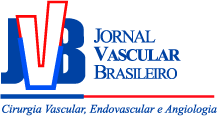Aneurismas da artéria e da veia braquial induzidos por uso contínuo de muleta: relato de caso
Aneurysms of brachial artery and vein induced by continuous use of crutch: case report
Débora Louise Lopes da Costa, Geraldo Felipe Junior, Marcos Aurélio Perciano Borges
Resumo
O aneurisma arterial induzido por uso de muleta é um evento raro, e a associação com aneurismas venosos não está descrita na literatura. Relatamos o caso de uma paciente que, após o uso prolongado dessa órtese, apresentou quadro de isquemia aguda de membro superior secundária à trombose de um aneurisma da artéria braquial, associado ao achado incidental de aneurismas da veia braquial. Embora a principal causa de oclusão arterial aguda de membro superior seja a embolização de fonte cardíaca, deve-se considerar a possibilidade de embolização arterioarterial por aneurismas provocados pelo uso prolongado de muletas. Os aneurismas venosos também devem ser suspeitados, uma vez que podem ser sede de trombos e fonte de êmbolos pulmonares.
Palavras-chave
Abstract
Crutch-induced arterial aneurysm is a rare event and there are no descriptions in the literature of cases with concomitant venous aneurysms. We report the case of a patient who, after prolonged crutch use, presented with acute ischemia of the upper limb secondary to brachial artery aneurysm thrombosis, associated with the incidental finding of brachial vein aneurysms. Although the main cause of acute upper limb occlusion is embolization of cardiac origin, consideration should be given to the possibility of arterio-arterial embolization due to an aneurysm induced by prolonged use of crutches. Venous aneurysms should also be suspected since they can be sites of thrombosis, and a source of pulmonary embolism.
Keywords
References
1. Furukawa K, Hayase T, Yano M. Recurrent upper limb ischaemia due to a crutch-induced brachial artery aneurysm. Interact Cardiovasc Thorac Surg. 2013;17(1):190-2. PMid:23529749. http://dx.doi.org/10.1093/icvts/ivt121.
2. Konishi T, Ohki S, Saito T, Misawa Y. Crutch-induced bilateral brachial artery aneurysms. Interact Cardiovasc Thorac Surg. 2009;9(6):1038-9. PMid:19783546. http://dx.doi.org/10.1510/icvts.2009.219832.
3. Basílio MR, Cantador AA, Molinari GJSP, Menezes FH. Oclusão arterial aguda de membro superior associada à utilização de muleta: relato de caso. J Vasc Bras. 2014;13(4):340-4.
4. Ettien JT. Crutch-induced aneurysms of the axillary artery. Am Surg. 1980;46(4):267-9. PMid:7386992.
5. Feldman DR, Vujic I, McKay D, Callcott F, Uflacker R. Crutch-induced axillary artery injury. Cardiovasc Intervent Radiol. 1995;18(5):296-9. PMid:8846468. http://dx.doi.org/10.1007/BF00203679.
6. Wallace JR, Baril DT, Chaer RA. Upper extremity venous aneurysm as a source of pulmonary emboli. Ann Vasc Surg. 2013;27(2): 240.e5-240.e8. PMid:23380560. http://dx.doi.org/10.1016/j.avsg.2012.05.019.
7. Gillespie DL, Villavicencio JL, Gallagher C, et al. Presentation and management of venous aneurysms. J Vasc Surg. 1997;26(5):845-52. PMid:9372824. http://dx.doi.org/10.1016/S0741-5214(97)70099-5.
8. Acin F, Benito L, Guilleuma J, Alvarez R. Primary axillary venous aneurysm. Ann Vasc Surg. 1999;13(5):539-40. PMid:10466998. http://dx.doi.org/10.1007/s100169900294.
9. Calligaro KD, Ahmad S, Dandora R, et al. Venous aneurysms: surgical indications and review of the literature. Surgery. 1995;117(1):1-6. PMid:7809821. http://dx.doi.org/10.1016/S0039-6060(05)80222-3.



